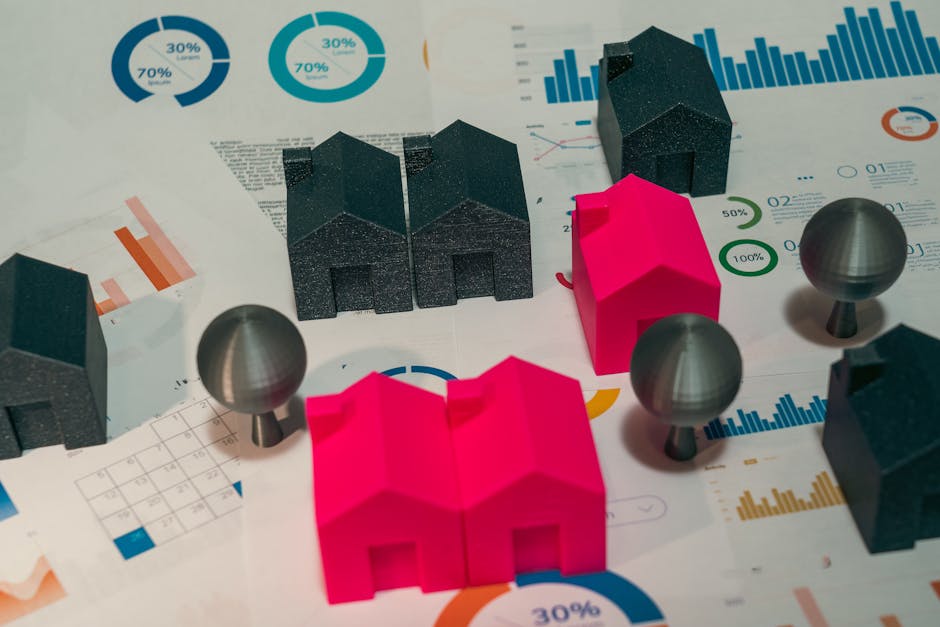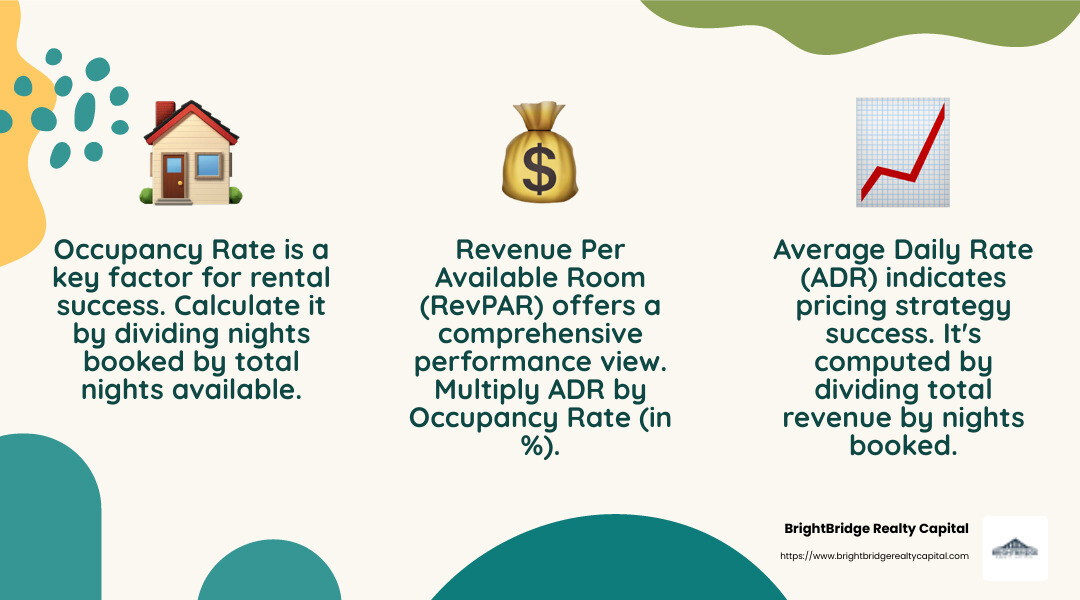From Dreams to Reality: Building a Vacation Rental Financial Model

Vacation rental financial model is crucial for anyone venturing into short-term rentals, whether it's a cozy cabin getaway or a chic urban loft. It’s not just about listing your property on Airbnb; it's about planning for profitability and growth. The right financial model can help you turn dreams of successful real estate investment into reality by outlining costs, revenues, and potential profits.
Want the quick rundown? Here's how a vacation rental financial model can help:
- Forecast Expenses and Revenues: Understand the cost of acquiring and maintaining properties versus the expected rental income.
- Evaluate Profit Potential: Calculate your return on investment using metrics like occupancy rates, average daily rates (ADR), and more.
- Make Informed Decisions: Use real-time data to adjust pricing and reduce costs for optimal profitability.
- Plan for Growth: Strategically manage multiple properties and expand your real estate portfolio with reduced risk.
Whether you're eyeing your first property or planning to expand your rental empire, this model is your roadmap to making sound investment decisions.

Vacation rental financial model further reading:
- financing a vacation home
- creative financing for rental property
- investment property loans with no down payment
Understanding the Basics of a Vacation Rental Financial Model
A vacation rental financial model is like a roadmap for your short-term rental business. It helps you understand the key elements that drive profitability and growth. Let's break down the basics: occupancy, price, costs, cash flow, and ROI.
Occupancy
Occupancy is the percentage of time your rental is booked. It's a critical metric because it directly impacts your revenue. For example, a downtown apartment might have a higher occupancy rate due to its location, while a mountain cabin might see more seasonal fluctuations.
To forecast occupancy, consider:
- Maximum Occupancy Rate: The highest possible occupancy during peak seasons.
- Seasonality Factors: Adjustments for slow months or off-peak times.
This helps you predict when your property will be in demand, allowing you to plan accordingly.
Price
Setting the right price is a balancing act. Charge too much, and you risk low occupancy. Charge too little, and you leave money on the table.
Consider these factors:
- Average Daily Rate (ADR): The average income per occupied night.
- Competitive Pricing: Compare similar properties in your area.
Use pricing strategies to maximize revenue, such as dynamic pricing, which adjusts rates based on demand.
Costs
Understanding costs is essential for profitability. They include:
- Operating Expenses: Maintenance, utilities, and management fees.
- Channel Expenses: Fees from platforms like Airbnb or Vrbo.
- Owner Expenses: Travel, administrative costs, and renovations.
Tracking these helps you identify areas to cut costs and improve margins.
Cash Flow
Cash flow is the net profit minus debt service. It tells you how much money is actually flowing in and out of your business. Positive cash flow means you have the funds to reinvest or cover unexpected expenses.
Return on Investment (ROI)
ROI measures the profitability of your investment. Key metrics include:
- Cash-on-Cash Return: Annual cash flow compared to total investment.
- Cap Rate: Return based on property value.
- Internal Rate of Return (IRR): Total annualized return, accounting for the cost of capital.
ROI helps you evaluate if your investment is worth it and guides future decisions.
By understanding these basics, you can create a robust vacation rental financial model that guides your investment journey. Whether you're just starting or looking to expand, these insights are your blueprint for success.
Key Metrics for Evaluating Vacation Rentals
When evaluating vacation rentals, understanding key metrics is crucial. These metrics help you gauge the performance and profitability of your property. Let's explore the most important ones: gross revenue, occupancy rate, Average Daily Rate (ADR), Revenue Per Available Room (RevPAR), and Average Length of Stay (ALOS).
Gross Revenue
Gross revenue is the total income generated from your vacation rental before any expenses are deducted. It's a straightforward measure of your property's earning potential. To calculate it, multiply your occupancy by the ADR and the number of available nights.
For example, if your rental is booked for 15 nights at an ADR of $200, your gross revenue would be $3,000 for that period.
Occupancy Rate
Occupancy rate is the percentage of nights your property is booked compared to the total number of nights available. High occupancy rates often indicate that your property is in demand.

To calculate it, use this formula:
[ \text{Occupancy Rate} = \left( \frac{\text{Nights Booked}}{\text{Total Nights Available}} \right) \times 100 ]
For instance, if your property is booked for 18 out of 30 nights, your occupancy rate is 60%.
Average Daily Rate (ADR)
ADR is the average income earned per occupied night. It's a key indicator of your pricing strategy's effectiveness.
To calculate ADR, divide your total revenue by the number of nights booked:
[ \text{ADR} = \frac{\text{Total Revenue}}{\text{Nights Booked}} ]
For example, if your total revenue is $4,500 for 18 nights, your ADR would be $250.
Revenue Per Available Room (RevPAR)
RevPAR combines occupancy rate and ADR to give a comprehensive view of your rental's performance. It shows how well you're using your available nights to generate revenue.
Calculate RevPAR by multiplying ADR by the occupancy rate:
[ \text{RevPAR} = \text{ADR} \times \left( \frac{\text{Occupancy Rate}}{100} \right) ]
Using the previous examples, if your ADR is $250 and occupancy rate is 60%, your RevPAR would be $150.
Average Length of Stay (ALOS)
ALOS measures how long guests typically stay at your property. It's calculated by dividing the total number of nights booked by the number of bookings.
For example, if your property is booked for 18 nights over 3 bookings, the ALOS would be 6 nights.

Understanding these metrics helps you make informed decisions about pricing, marketing, and property management. By tracking them regularly, you can optimize your vacation rental financial model and improve profitability.
Building Your Vacation Rental Financial Model
Creating a vacation rental financial model is like building a roadmap for your rental business. It helps you track income, manage expenses, and understand tax implications. Let's break down the essentials.
Spreadsheet Templates
Start with a simple spreadsheet template. This will be your go-to tool for tracking all your financial data. You can create one in Google Sheets or Excel.
Key columns to include:
- Date: When the transaction occurred.
- Description: What the transaction was for.
- Income: Money coming in from bookings.
- Expenses: Money going out for costs.
- Balance: Income minus expenses.
Using a template saves time and ensures consistency. It helps you see the big picture at a glance.
Income Tracking
Tracking income is crucial. You need to know exactly how much your property is earning.
Here's what to track:
- Gross Revenue: Total income before expenses.
- Net Income: Income after deducting expenses.
Use tools like Airbnb’s reporting features or property management software to automate this process. This keeps your records accurate and up-to-date.
Expense Tracking
Expenses can eat into your profits if not managed well. Keep a close eye on where your money is going.
Common expenses include:
- Maintenance and Repairs: Regular upkeep and unexpected fixes.
- Utilities: Water, electricity, internet, etc.
- Marketing: Costs for advertising and listing fees.
- Cleaning Fees: Costs for turning over the property between guests.
Categorizing expenses helps you identify areas where you can cut costs and improve your bottom line.
Tax Implications
Taxes can be tricky for vacation rentals. You need to understand the rules to avoid surprises.
Key points to consider:
- Deductible Expenses: Some costs, like repairs and mortgage interest, may be tax-deductible.
- Rental Income Reporting: You must report all rental income to the IRS.
- Depreciation: You can depreciate the property over time to reduce taxable income.
Consult a tax professional to ensure you’re compliant and taking advantage of any deductions available to you.
Building your financial model with these components gives you a clear picture of your rental’s performance. It helps you make informed decisions and plan for growth.
Next, we'll explore the tools and resources that can make managing your vacation rental even easier.
Tools and Resources for Managing Vacation Rentals
Managing a vacation rental can be complex, but with the right tools, it becomes much easier. Let's explore some essential resources to streamline your operations and boost your efficiency.
STR Software
Short-term rental (STR) software is a game-changer for property management. It automates many tasks, helping you save time and reduce errors.
Key benefits of STR software:
- Automated Booking Management: Handles reservations and calendar syncing across platforms.
- Guest Communication: Sends automated messages and responses to guests.
- Pricing Optimization: Adjusts prices based on market demand and competition.
Using STR software keeps your operations smooth and your guests happy.
Financial Management Tools
Effective financial management is crucial for the success of your vacation rental. It involves setting clear goals and tracking progress.
Steps for financial planning:
- Set Revenue Targets: Establish how much income you want to generate.
- Budget for Expenses: Plan for costs like maintenance, marketing, and utilities.
- Monitor Cash Flow: Ensure that income consistently exceeds expenses.
A solid financial plan helps you stay on track and achieve your investment goals.
Property Management
Property management is at the heart of a successful vacation rental. It involves maintaining the property and ensuring a great guest experience.
Key aspects of property management:
- Regular Maintenance: Keep the property in top condition to attract and retain guests.
- Guest Services: Provide amenities and support to improve the guest experience.
- Cleaning and Turnover: Ensure the property is spotless and ready for new guests.
Good property management leads to positive reviews and repeat bookings.
By leveraging these tools and resources, you can manage your vacation rental more efficiently and maximize your returns. Up next, we'll answer some frequently asked questions about vacation rental financial models.
Frequently Asked Questions about Vacation Rental Financial Models
What are the primary components of a vacation rental financial model?
A vacation rental financial model is your blueprint for success. It helps you understand how your rental property will perform financially. Here are the main components:
Occupancy: This is the percentage of time your property is rented out. A higher occupancy rate means more income, but it also brings more wear and tear. Balancing occupancy with maintenance is key to long-term profitability.
Price: This includes your average daily rate (ADR). The ADR may change with seasons or local events. Pricing your property right is crucial to staying competitive and attracting guests.
Costs: These cover everything from utilities and maintenance to marketing and cleaning fees. Keeping a close eye on costs helps ensure your rental remains profitable.
How can I optimize my vacation rental for profitability?
Optimizing your vacation rental means getting the most return for your investment. Here’s how:
Pricing Strategies: Use dynamic pricing to adjust your rates based on demand, season, and competition. This helps maximize your revenue potential.
Expense Management: Track all expenses and look for areas to cut costs without sacrificing quality. Regularly review your spending to find savings opportunities.
Occupancy Boosting: Increase your occupancy by offering discounts for longer stays or during off-peak seasons. Enhancing your property with desirable amenities can also attract more guests.
What tools can help automate financial tracking for vacation rentals?
Automation can save you time and reduce errors in managing your rental's finances. Here are some tools that can help:
STR Software: This software automates booking, guest communication, and pricing. It keeps your operations smooth and helps optimize your revenue.
Stessa: A powerful tool for financial tracking, Stessa connects to your accounts to automatically track income and expenses. It offers performance dashboards and tax-ready reports, making financial management a breeze.
Utilizing these tools can help you manage your vacation rental more efficiently, allowing you to focus on growing your business and achieving your financial goals.
Conclusion
In real estate investment, building a vacation rental financial model is more than just numbers on a spreadsheet. It's about changing dreams into reality by making informed decisions that drive profitability. At BrightBridge Realty Capital, we understand the importance of having a solid financial foundation. Our real estate financing solutions are custom to help you achieve your investment goals with speed and flexibility.
Real estate financing can be complex, but we're here to make it simple. Our direct lending approach means no middlemen, allowing us to offer competitive rates and fast closings—often within a week. This ensures you can seize opportunities when they arise, keeping your investment strategy on track.
Investment strategies for vacation rentals require careful planning and execution. By leveraging our expertise and resources, you can optimize your property's financial performance. Whether it's through smart pricing strategies, effective expense management, or boosting occupancy, we provide the support you need to make your investment a success.
Let us help you bridge the gap between your investment dreams and financial reality. Explore our customized real estate financing solutions and find how BrightBridge Realty Capital can be your partner in building a profitable vacation rental business.


